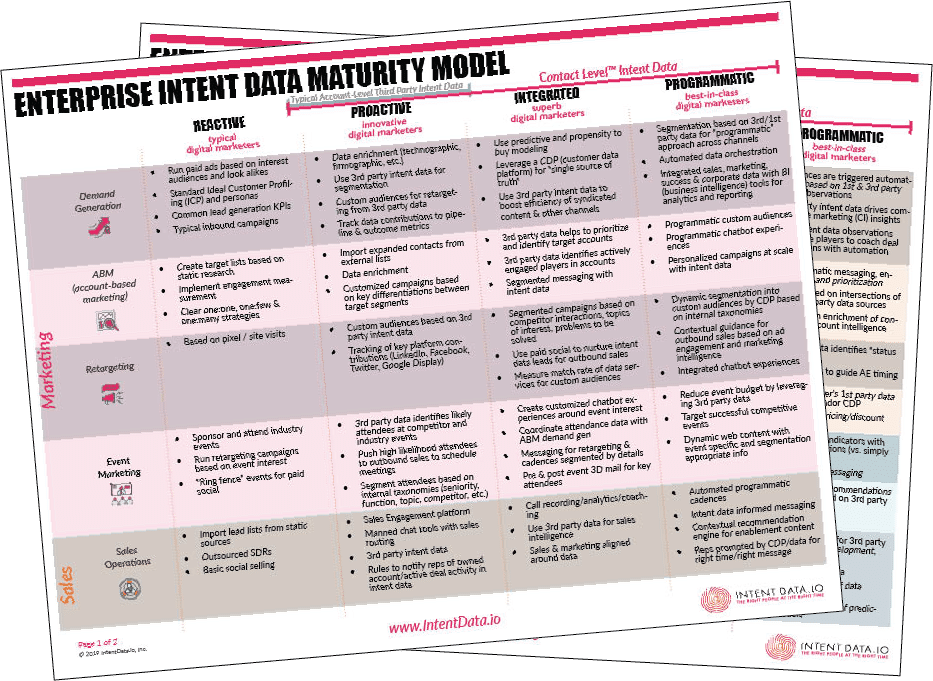TL;DR - Contact level™ intent data provides amazing and surprising insights and answers to tactical marketing and sales questions. The power of the data, though, leads to discussions which often increase awareness that the full value of data for ABM, demand generation, campaign orchestration, retargeting, churn reduction and other use cases often requires data management capabilities missing from the typical marketing automation and CRM in the MarTech stack. That leads to discussions around customer data platforms (CDP) and, gradually, a better understanding of a company's data, it's limitations and it's potential.
Data Awareness
Data driven marketing.
We hear that a lot.
Which landing pages convert? Views of which pages correlate most with closed/won deals? What persona based forms produce the most fields completed? What pages yield the most inbound links? All interesting examples, and all details which can inform tactical adjustments to content marketing approaches.
Digital marketers have an amazing array of tools and information upon which they now rely. The MarTech stack now accounts for approximately 30% of the entire marketing budget in North America. Marketing Automation platforms rarely stand alone. Account-based marketing (ABM), business intelligence (BI), chat, optimization, social listening, video, project management and a host of other categories are commonly found in the Martech Stack.
Complex sales teams have their own data insights. CRMs have evolved to help teams visualize complex buying team relationships, to simplify activity capture and even to suggest "next steps" using AI.
Ecommerce teams have transactional and abandoned cart details.
Success teams have utilization data.
And on and on.
And the good news is that they all often integrate - in other words there's an API connection that let's you see various sets of data from other applications and perhaps even trigger some actions.
It's data galore! It's exciting! And it hides a lurking problem.
Mixing 3rd Party Intent Data with 1st Party Data
We speak with a lot of people that are considering adding third-party data to their Martech tool kit, and others who are disillusioned with the capability of account-level surge data and wondering whether contact level data would deliver the results they envisioned when they began their intent data journey.
Conversations follow a typical pattern, beginning with details around how data is collected publicly, the information provided, and the likely volume of signals. Next they have questions about integration with CRM and marketing automation tools. And later they start to visualize how they'll segment and prioritize information.
How can they leverage multiple 3rd party data sources? How will they be able to easily pull the ideal custom audience for a specifically targeted paid social nurturing campaign? How will they efficiently differentiate between single signals at unknown accounts vs. new contacts in their ABM one:many lists, or even those in accounts with pending opportunities? How can they automatically trigger programmatic outbound cadences? And most importantly, how can they track aggregate activity to identify important events such as when a threshold of 3rd party data signals is met, or the coincidence of 1st party signal with some significant 3rd party observations? (This is the powerful combination that makes TechTarget such a valued partner. Their contact level 2nd party intent signals, integrated with a company's 1st party data is a driver of results.)
Suddenly it's clear how many important, tactical, marketing, sales and success questions can be potentially answered with contact level data. Beyond a simple barometer of account level activity, contact level data can provide a detailed picture of what's happening in the account by piecing together the mosaic of what's happening with individual players - over time.
As those tactical questions are answered, however, a strategic question emerges.
What is their system of record? Further, while sharing data between applications is now standard, how can they automatically draw on insights from aggregated information in one platform to augment and activate another?
Suddenly it's clear. There's neither a truly unified customer experience, nor a unified revenue management experience.
Gulp....
Meta Platforms
Of course third party data isn't the only trigger for this awareness.
Scott Brinker's keynote at MarTech East 2019 predicted that this will be the year of "platform marketing." Customer Data Platform (CDP) venders were disproportionally represented among the exhibitors and sponsors of that same event.
High level initiatives that require operations and actions based on integrated (not just synced) data, like ABM and channel revenue operations, expose the gaps between systems which talk but don't collaborate.
Here's the question for your organization. Who's responsible / where's the consolidated document for tracking those natural questions that arise as you and your team seek to creatively digest and activate data?
Overlaying a CDP on top of a CRM and marketing automation system will be hard to justify as a database. By documenting the important tactical steps that you want to take to deliver a better customer experience and enhance your revenue growth, but can't, you'll start to accumulate the justification info you need.
Not to mention the time you might save by halting the propagation of crappy data across platforms.
Is a CDP the Answer?
Honestly, it's probably not clear yet. Today savvy marketers in mid-size companies are asking the questions listed above, and others like:
- What if we could.....?
- Why can't we.....?
- What would make this a better buyer experience?
- When will be able to answer......?
They're also wrestling with dirty and poorly coordinated data. Data that not only causes them to miss opportunities, but likely to disrupt others because of the poor experience that results.
It's easy to grasp for yet another MarTech tool. That may be the answer, but you've certainly experienced both freemium and planned implementations that failed to deliver. There are clear cons to quickly implementing a customer data platform.
- Cost often depends on the number of records and frequency with which you sync sources.
- The implementation process will raise questions that have been easier to ignore around data quality. At the very least those will take time to quantify, debate, resolve and execute.
- Any software implementation requires planning and work, even though it's probably feasible to manage it within marketing and without IT support.
- And perhaps most significantly, you'll have to create extensive new playbooks. You'll have significantly enhanced capability to deliver better buyer journeys and customer experience - but that wont happen by simply running old, limited process with the new platform.
Clearly there are benefits.
- Improved data insight and quality including the value of a system of record, multiple correlated data points about each contact, and better regulatory (e.g. GDPR) control.
- Real time segmentation (and with contact level intent data, programmatic personalization.)
- Better understanding of prospects, buyers and market.
- Substantial time savings in complex campaign creation.
- Improved buyer experience - which should in turn lead to higher close rates and shorter sell cycles.
- Improved reporting.
- Predictive capabilities.
- And of course, the capability that we often see trigger the awareness, the ability to fully incorporate and activate third-party data sources including integrating them with zero-party and first-party data.
Maybe it's fitting that the power of contact level third party data to deliver insights and answer tactical questions often prompts the strategic questions around data management that lead to CDP discussions.
After the quick and easy wins are achieved in weeks and months, companies start to push to the right in their intent data maturity, and start to consider how to unlock even more value from all their data, and particularly from combinations.





